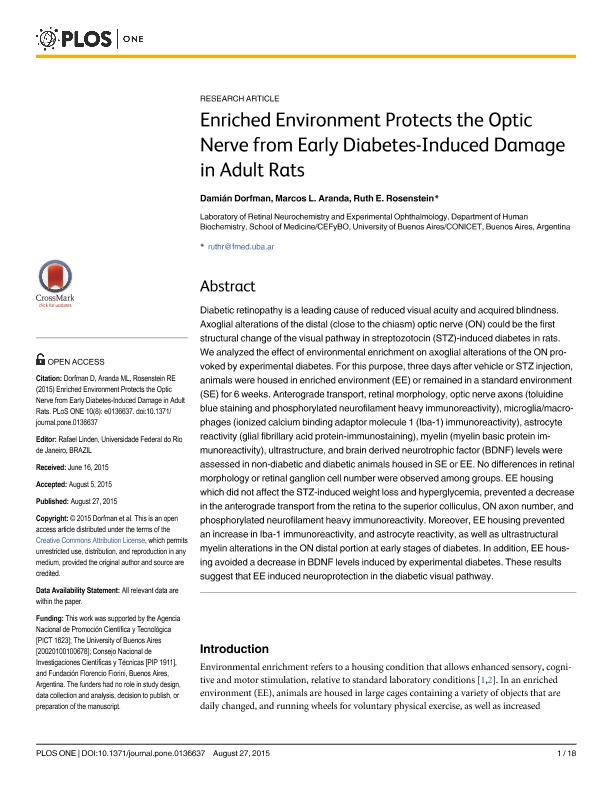Artículo
Enriched environment protects the optic nerve from early diabetes-induced damage in adult rats
Fecha de publicación:
08/2015
Editorial:
Public Library Of Science
Revista:
Plos One
ISSN:
1932-6203
Idioma:
Inglés
Tipo de recurso:
Artículo publicado
Clasificación temática:
Resumen
Diabetic retinopathy is a leading cause of reduced visual acuity and acquired blindness. Axoglial alterations of the distal (close to the chiasm) optic nerve (ON) could be the first structural change of the visual pathway in streptozotocin (STZ)-induced diabetes in rats. We analyzed the effect of environmental enrichment on axoglial alterations of the ON provoked by experimental diabetes. For this purpose, three days after vehicle or STZ injection, animals were housed in enriched environment (EE) or remained in a standard environment (SE) for 6 weeks. Anterograde transport, retinal morphology, optic nerve axons (toluidine blue staining and phosphorylated neurofilament heavy immunoreactivity), microglia/macrophages (ionized calcium binding adaptor molecule 1 (Iba-1) immunoreactivity), astrocyte reactivity (glial fibrillary acid protein-immunostaining), myelin (myelin basic protein immunoreactivity), ultrastructure, and brain derived neurotrophic factor (BDNF) levels were assessed in non-diabetic and diabetic animals housed in SE or EE. No differences in retinal morphology or retinal ganglion cell number were observed among groups. EE housing which did not affect the STZ-induced weight loss and hyperglycemia, prevented a decrease in the anterograde transport from the retina to the superior colliculus, ON axon number, and phosphorylated neurofilament heavy immunoreactivity. Moreover, EE housing prevented an increase in Iba-1 immunoreactivity, and astrocyte reactivity, as well as ultrastructural myelin alterations in the ON distal portion at early stages of diabetes. In addition, EE housing avoided a decrease in BDNF levels induced by experimental diabetes. These results suggest that EE induced neuroprotection in the diabetic visual pathway.
Palabras clave:
Diabetic Retinopathy
,
Optic Nerve
,
Enriched Environment
,
Adult Rats
Archivos asociados
Licencia
Identificadores
Colecciones
Articulos(CEFYBO)
Articulos de CENTRO DE ESTUDIOS FARMACOLOGICOS Y BOTANICOS
Articulos de CENTRO DE ESTUDIOS FARMACOLOGICOS Y BOTANICOS
Citación
Dorfman, Damián; Aranda, Marcos L.; Rosenstein, Ruth Estela; Enriched environment protects the optic nerve from early diabetes-induced damage in adult rats; Public Library Of Science; Plos One; 10; 8; 8-2015; 136637-136646
Compartir
Altmétricas




